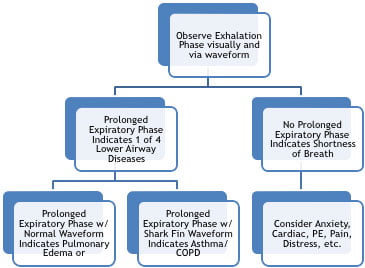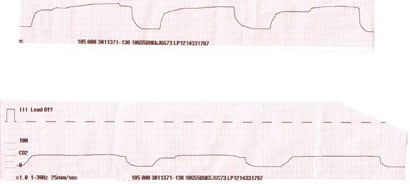The capnography waveform, not the ETCO2 number, is used for airway assessment. If the patient ventilates, or you ventilate the patient, and a boxy waveform appears, then that breath is patent and went in and out of the lungs unobstructed. When your patient begins to exhale you should see a vertical rise from baseline. The exhalation phase is represented by the top of the waveform and the width of the waveform indicates the expiratory time. The top of the waveform should be flat indicating equal pressure distribution throughout the exhalation phase and no obstruction of flow. During inhalation, no more CO2 is detected and you see the backside of the waveform return to baseline. Therefore, the upslope and top of the waveform is the exhalation phase and the downslope and back of the waveform is the inhalation phase. NEED NORMAL WAVEFORM GRAPHIC
If your patient has an obstruction issue such as asthma, there will not be a flat top to the waveform. Instead you will observe a positive slope (negatively sloped waveforms are artifact in origin and do not have a physiologic explanation). A positive slope tells you there is less pressure at the beginning of the breath than at the end of the breath. This means your patient is unable to maintain equal pressure distribution throughout the exhalation phase. This waveform morphology is referred to as a “shark fin” and is indicative of an obstruction issue; the steeper the slope, the more severe the obstruction pathology. If your patient is on a capnography cannula, think asthma, and to some degree COPD; although, in my experience, COPD exacerbations cause unimpressive shark fins compared to asthma. If a shark fin develops in an intubated situation, first suction the tube and make sure it is not kinked before heading down the path of an inline neb. When the airway circuit is obstructed, a shark fin can develop despite no obstruction pathology with the patient. Do NOT spend time studying computer generated shark fin waveforms as you will never see them in real life. A real shark fin waveform will be wide and it will not have a crazy slope that you can ski or surf.

One of the most important things to focus on during the initial impression of a spontaneously breathing respiratory patient is their exhalation phase; is it normal or prolonged? Observing a prolonged exhalation phase indicates a lower airway disease and there are only 4 categorically that we deal with: alveoli issues (e.g. emphysema), bronchoconstriction issue (e.g. asthma), pulmonary edema (e.g. CHF, HAPE, ARDS, etc.) or respiratory infection (e.g. pneumonia, bronchitis, bronchiolitis, etc.). There are 2 ways to identify a prolonged expiratory phase: look at how your patient is breathing or look for an abnormally wide waveform with your capnography assessment. Even if you don’t see a prolonged expiratory phase when you observe your patient, always double check the waveform. It will sometimes be more sensitive than your eyes as it may be hard to see the rise and fall of your patient’s chest due to clothing, position, people in the way, etc. If your patient has a normal expiratory phase, then consider a shortness of breath problem instead of “labored breathing” and go down the path of anxiety, cardiac, PE, pain, distress, etc.
If your patient has a prolonged expiratory phase, focusing on the top of the waveform can narrow 4 options down to 2. A prolonged expiratory phase with a shark fin waveform is most commonly going to be a COPD/asthma issue. A prolonged expiratory phase with a normal waveform that has a flat top is most commonly going to be CHF or a respiratory infection. Pulmonary edema does not cause a shark fin because CO2 is very soluble in water and diffuses through fluid at the same rate it does through air. Respiratory infections do not cause a shark fin because the lungs are overbuilt and the breath can typically find a path of least resistance around the “gunk and junk”. If you swear your patient is suffering from a CHF exacerbation or pneumonia and you observe a shark fin, consider 2 things: you’re wrong, or an additional bronchoconstriction pathology is in play.

One final thought, when trying to determine if your prolonged expiratory patient has a normal waveform or a shark fin, focus on the TOP of the waveform and do not look for a zebra in a herd of elephants; look for the overall trend of the waveforms. Know that all lower airway disease patients with a prolonged expiratory phase will begin their waveform with a less vertical rise to the top that lays over, as it takes longer for them to clear their dead space air and get into the CO2 rich alveolar air that the top of the waveform represents. Also, all lower airway disease patients suffer from varying degrees of atelectasis, which is what causes the slur from the upslope to the top of the waveform. A slur to the waveform top does NOT define a shark fin. If the waveform slurs and slopes, that is a shark fin. Be confirmed in your COPD/asthma suspicions and then use the waveform, ETCO2 and clinical picture to trend improvement. If your patient’s waveform slurs and flattens out, that is a normal waveform and you should consider pulmonary edema and respiratory infection if you are not already headed down that path. Both of the following waveforms show a prolonged expiratory phase. Even though both waveforms begin with a slur, hopefully you can see that the top waveform is the shark fin indicating asthma/COPD and the bottom waveform is a normal waveform indicating CHF/pneumonia.

Troy Valente (pronounced "va-len-tee") was born and raised in California and has lived in Northern Colorado since 2001 with his wife (a NICU nurse) and two kids. Troy started his EMS career in 2002. becoming a paramedic in 2006. Prior to that, he attended Pepperdine University and The University of Northern Colorado, where he received a bachelor’s degree in exercise science with a sports medicine minor.
Feel free to reach out directly to Troy via email: [email protected].


